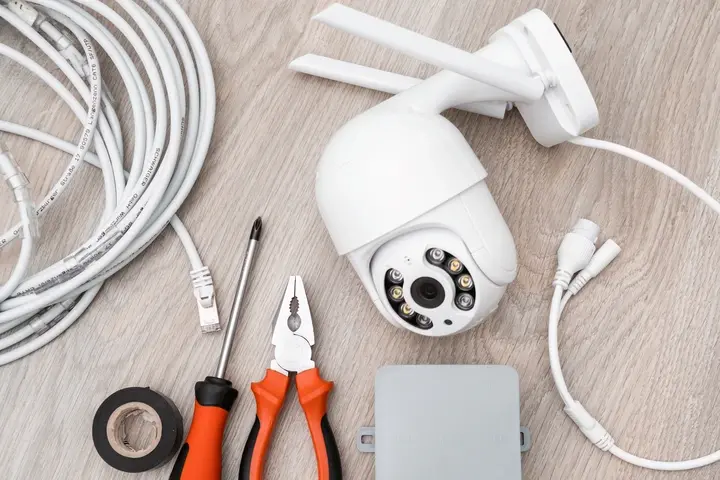
In an era where safety and security are paramount, setting up security cameras has become a crucial aspect of safeguarding homes and properties. Whether you're concerned about burglary, or vandalism, or simply want to monitor your surroundings, installing security cameras provides a proactive approach to maintaining a secure environment. This comprehensive guide will walk you through the step-by-step process of setting up security cameras, ensuring that you optimize their functionality to enhance your overall safety.
Planning Your Surveillance System:
Before diving into the installation process, it's essential to plan your surveillance system strategically. Identify key areas that require Monitored Systems, such as entry points, driveways, and vulnerable spots around your property. Consider the type of security cameras that best suit your needs – whether it's wired or wireless, indoor or outdoor, and the resolution required for clear image capture.
Choosing the Right Security Cameras:
Selecting the appropriate security cameras is crucial for the effectiveness of your surveillance system. Dome cameras are discreet and ideal for indoor use, while bullet cameras are more conspicuous and designed for outdoor applications. Wireless cameras offer flexibility in installation, while wired cameras may provide a more reliable connection. Ensure that the cameras you choose are weather-resistant if they are intended for outdoor use.
Essential Equipment and Tools:
Gather all the necessary equipment and tools before starting the Professionally Installed Systems. This may include security cameras, mounting brackets, power adapters, cables, a power drill, screwdrivers, and a monitor or recording device. Having everything on hand will streamline the installation process and reduce potential delays.
Determining Camera Placement:
Proper camera placement is crucial for maximizing the coverage of your surveillance system. Consider factors such as the camera's field of view, angles, and potential obstructions. Install cameras at entry points, near valuables, and in areas with low visibility. Ensure that cameras are mounted at a height that discourages tampering while still capturing clear images.
Installing Security Cameras:
A. Wired Cameras:
- Begin by installing the mounting brackets securely on the chosen locations.
- Connect the camera to the power source using the provided power cables.
- Run the video cables from each camera to a central location where the recorder will be placed.
- Ensure all connections are tight and weatherproof to prevent any damage.
B. Wireless Cameras:
- Mount the cameras in the chosen locations, ensuring a clear line of sight to the receiver.
- Power the cameras using batteries or an external power source.
- Connect the receiver to the recording device or monitor using the provided cables.
Setting Up the Centralized Recording System:
If you opt for a centralized recording system, connect the cameras to a digital video recorder (DVR) or network video recorder (NVR). Ensure that the recorder is placed in a secure location, protected from tampering. Configure the recording settings, such as motion detection and recording schedules, to optimize storage space and capture relevant footage.
Connecting to a Monitoring System:
For real-time monitoring, connect your surveillance system to a monitoring device. This could be a dedicated monitor, a computer, or even a smartphone through a dedicated app. Ensure that the monitoring device is located in a convenient and secure location, allowing you to keep an eye on your property at all times.
Configuring Motion Detection and Alerts:
Most modern Security Cameras come equipped with motion detection features. Configure the sensitivity settings to avoid false alarms triggered by irrelevant movements, such as swaying branches. Set up email or mobile notifications to receive alerts when suspicious activity is detected, providing timely information to take appropriate action.
Regular Maintenance and Updates:
To ensure the continued effectiveness of your security cameras, perform regular maintenance checks. Clean camera lenses, clear any debris that may obstruct the view, and inspect cables for wear and tear. Additionally, keep firmware and software up-to-date to benefit from the latest security enhancements and features.
Additional Tips for Enhanced Security:
A. Secure Access to the Surveillance System:
- Set up secure passwords and usernames for accessing your surveillance system to prevent unauthorized access.
B. External Lighting:
- Install external lighting to enhance visibility and deter potential intruders, improving the overall effectiveness of your security system.
C. Legal Considerations:
- Familiarize yourself with local laws and regulations regarding the use of security cameras to ensure compliance with privacy and recording restrictions.
FAQ's
What equipment do I need to set up security cameras?
Understand the essential equipment required for setting up security cameras, including cameras, a digital video recorder (DVR) or network video recorder (NVR), power sources, and necessary cables.
Where should I place my security cameras for optimal coverage?
Learn about strategic locations to install security cameras for maximum coverage and effectiveness. Consider factors such as entry points, high-traffic areas, and vulnerable points around your property.
How do I power and connect my security cameras?
Get step-by-step guidance on powering and connecting security cameras. This includes information on power sources, cable types (wired or wireless), and the proper configuration of cables to ensure a reliable connection.
What features should I look for in security camera systems?
Understand the key features to consider when choosing a security camera system, such as resolution, night vision capabilities, motion detection, remote viewing options, and compatibility with mobile devices.
How do I set up remote monitoring for my security cameras?
Learn the steps to enable remote monitoring of your security cameras, allowing you to view live footage or receive alerts on your smartphone, tablet, or computer. This may involve setting up a dedicated app or accessing a web portal for your camera system.
Conclusion:
Setting up security cameras is a proactive step towards fortifying your home or property. By carefully planning, choosing the right equipment, and following a systematic installation process, you can establish a robust surveillance system that contributes to a safer and more secure environment. Regular maintenance and adherence to best practices will ensure that your security cameras remain effective in safeguarding your property for years to come.

